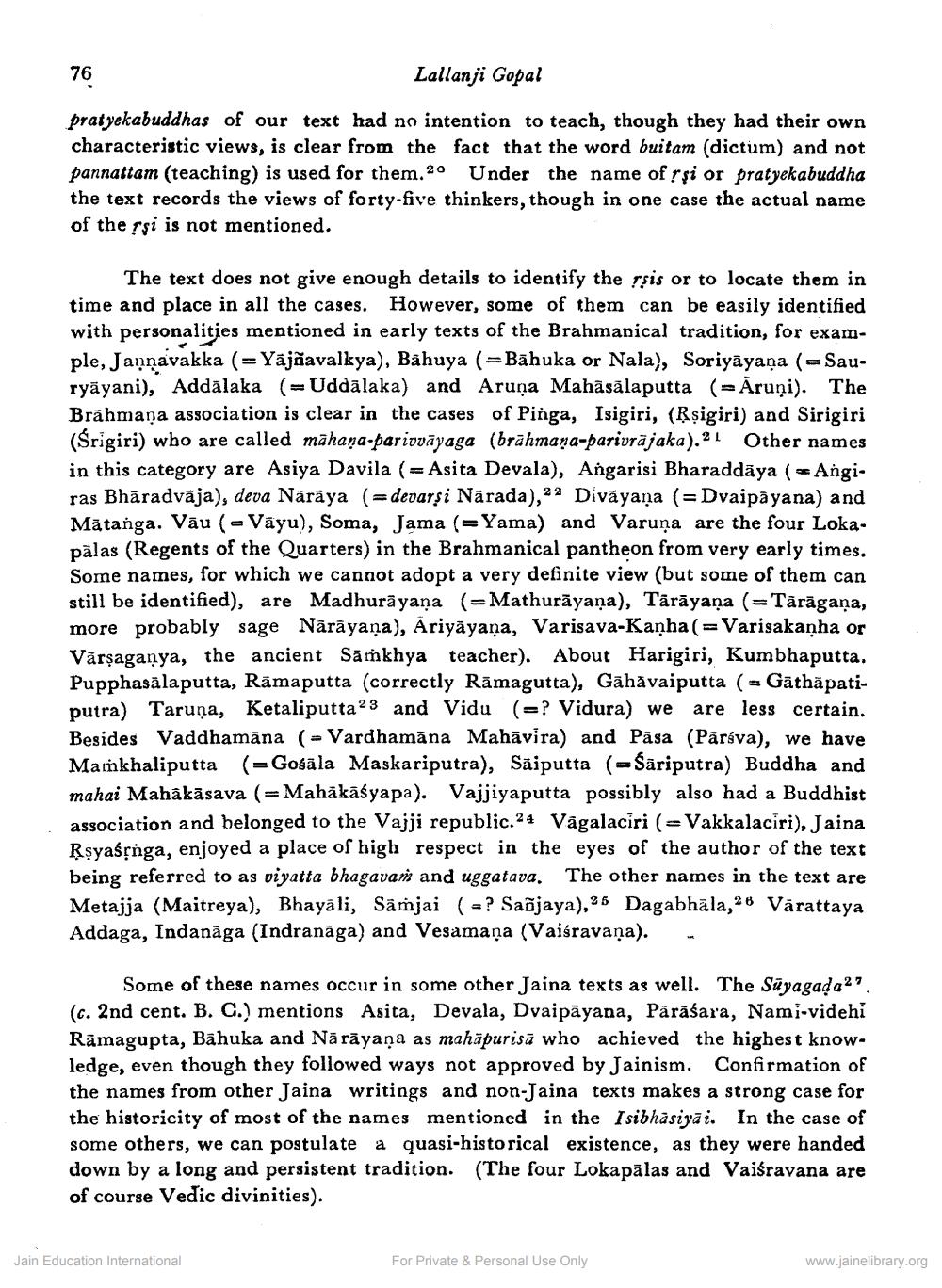Book Title: Asita Deval in Isibhasiyai Author(s): Lallan Gopal Publisher: Z_Aspect_of_Jainology_Part_3_Pundit_Dalsukh_Malvaniya_012017.pdf View full book textPage 3
________________ 76 Lallanji Gopal pratyekabuddhas of our text had no intention to teach, though they had their own characteristic views, is clear from the fact that the word buitam (dictum) and not pannattam (teaching) is used for them.20 Under the name of r și or pratyekabuddha the text records the views of forty-five thinkers, though in one case the actual name of the rşi is not mentioned. The text does not give enough details to identify the rșis or to locate them in time and place in all the cases. However, some of them can be easily identified with personalities mentioned in early texts of the Brahmanical tradition, for example, Jannavakka (=Yājāavalkya), Bahuya (=Bāhuka or Nala), Soriyāyana (=Sauryāyani), Addalaka (= Uddalaka) and Aruna Mahāsālaputta (= Aruņi). The Brahmana association is clear in the cases of Pinga, Isigiri, (Rsigiri) and Sirigiri (Srigiri) who are called māhana-parivvāyaga (brāhmana-parivrăjaka).21 Other names in this category are Asiya Davila ( = Asita Devala), Angarisi Bharaddāya (Angiras Bhāradvāja), deva Nārāya (=devarsi Nārada),22 Divāyaṇa (= Dvaipāyana) and Mātanga. Vāu (- Vayu), Soma, Jama (=Yama) and Varuna are the four Lokapālas (Regents of the Quarters) in the Brahmanical pantheon from very early times. Some names, for which we cannot adopt a very definite view (but some of them can still be identified), are Madhurāyana (=Mathurāyana), Tārāyaṇa (= Tārāgana, more probably sage Nārāyana), Ariyāyaṇa, Varisava-Kanha (=Varisakanha or Várşaganya, the ancient Sā mkhya teacher). About Harigiri, Kumbhaputta. Pupphasälaputta, Rāmaputta (correctly Rāmagutta), Gāhāvaiputta (= Gāthăpatiputra) Taruņa, Ketaliputta23 and Vidu (=? Vidura) we are less certain. Besides Vaddhamāna (- Vardhamāna Mahāvira) and Pasa (Paráva), we have Mamkhaliputta (= Gosāla Maskariputra), Sãiputta (=Sāriputra) Buddha and mahai Mahakāsava (=Mahākāśyapa). Vajjiyaputta possibly also had a Buddhist association and belonged to the Vajji republic.24 Vāgalaciri (=Vakkalaciri), Jaina Rşyaśộnga, enjoyed a place of high respect in the eyes of the author of the text being referred to as viyatta bhagavam and uggatava. The other names in the text are Metajja (Maitreya), Bhayali, Samjai ( = ? Saõjaya), 25 Dagabhāla, 28 Värattaya Addaga, Indanāga (Indranāga) and Vesamaņa (Vaiśravaņa). - Some of these names occur in some other Jaina texts as well. The Süyagada27. (c. 2nd cent. B. C.) mentions Asita, Devala, Dvaipāyana, Pārāśara, Nami-videhi Rāmagupta, Bāhuka and Nārāyana as mahāpurisā who achieved the highest knowledge, even though they followed ways not approved by Jainism. Confirmation of the names from other Jaina writings and non-Jaina texts makes a strong case for the historicity of most of the names mentioned in the Isibhāsiya i. In the case of some others, we can postulate a quasi-historical existence, as they were handed down by a long and persistent tradition. (The four Lokapālas and Vaiśravana are of course Vedic divinities). Jain Education International For Private & Personal Use Only www.jainelibrary.orgPage Navigation
1 2 3 4 5 6 7 8 9 10 11 12 13 14
